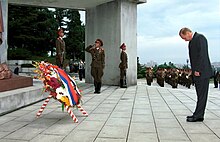Liberation Tower
The Liberation Tower ( Korean 해방 탑 , 解放塔 haebangt'ap ) is an obelisk in the North Korean capital Pyongyang to commemorate the soldiers of the Red Army , which on August 24, 1945 Pyongyang occupied and Korea for independence from the Japanese Empire mitverhalfen.
It is located in Moranbong Park in the inner city district of Chung-guyŏk near the entrance to the Rungna Bridge and is a focal point for state delegations and tourists. According to a tradition, it is also frequently visited by newlyweds.
history
The monument was built in 1946. In the Korean War it was heavily damaged and rebuilt after the war. A restoration was carried out in 1985.
Originally the Liberation Tower also contained a memorial plaque for Josef Stalin . This was removed in 1959 in the run-up to a planned state visit by Nikita Sergejewitsch Khrushchev . However, the visit did not take place. In 1960, a postage stamp with a motif of the tower was issued in the Soviet Union on the occasion of the 15th anniversary of Korean independence; also in 1975 on the occasion of the 30th and August 1st, 1985 on the occasion of the 40th anniversary.
In July 2000, during a state visit to North Korea in front of the Liberation Tower, Russian President Vladimir Putin commemorated the fallen Soviet soldiers with a wreath-laying ceremony.
construction
The monument is located on an elevation and is accessible via stairs. It consists of a stele with a five-pointed red star on top . Its total height is 30 meters.
Inscriptions
The historical background of the monument can be read in Korean and Russian on the base of the stele.
Russian text on the front:
«Великий советский народ разгромил японских империалистов и освободил корейский народ. Кровью, пролитой советскими воинами при освобождении Кореи, еще больше укрепилиси узрепилиси узик. В знак всенародной благодарности воздвигнут этот памятник. 15 августа 1945 года. »
“The great Soviet people crushed the Japanese imperialists and liberated the Korean people. The bonds of friendship between the Korean and Soviet peoples were further strengthened by the blood shed by the Soviet soldiers in the liberation of Korea. This monument was erected as a token of the gratitude of the whole people. August 15, 1945 "
Russian text on the back:
"Вечная слава великой Советской Армии, освободившей корейский народ от ига японских империалистов и открывшей ему путь к свободе и независимости! 15 августа 1945 г. »
“Eternal glory of the great Soviet army, which freed the Korean people from the yoke of the Japanese imperialists and opened the way to freedom and independence! August 15, 1945 "
While the inscription on the Tower of Liberation emphasizes that Korea's independence came through the intervention of the Soviet Union , official North Korean historiography says that the Japanese Empire was defeated by Kim Il-sung in the partisan struggle . The Liberation Tower is thus in a certain way in contradiction to, for example, the triumphal arch in the same city district .
See also
Web links
Individual evidence
- ^ Philipp Meuser (Ed.): Architectural Guide Pyongyang. Volume 2: Background and Comments. DOM publishers, Berlin 2011, ISBN 978-3-86922-126-7 , pp. 94-95.
- ↑ North Korea Online Travel Guide ( page no longer available , search in web archives ) Info: The link was automatically marked as defective. Please check the link according to the instructions and then remove this notice. vnc.nl (English)
- ↑ Russian President Putin's visit to North Korea in the year Juche 89 (2000) (video report in Korean)
- ^ Rüdiger Frank : North Korea. Deutsche Verlags-Anstalt, Munich 2014, ISBN 978-3-421-04641-3 , p. 37.
Coordinates: 39 ° 2 ′ 6.4 " N , 125 ° 45 ′ 30.6" E




